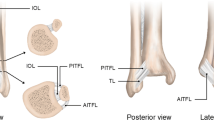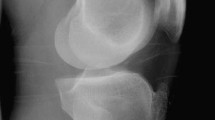Abstract
Purpose
The purpose of this study was to clarify radiographic and clinical outcomes, as well as their association, of ankle sprain in children.
Methods
Patients who sustained a first-time ankle sprain were prospectively surveyed. Patients underwent radiography of the ankle in the mortise, lateral, anterior talofibular ligament (ATFL), and calcaneofibular ligament views at the first clinic visit to assess avulsion fractures of the distal fibula. Patients with avulsion fractures underwent radiography after 8 weeks to assess bone union. The treatment method was not standardized and was determined by the patient, their parents, and the treating physician. Recurrent sprain and quality of life were evaluated by using the Self-Administered Foot Evaluation Questionnaire and reviewing the medical records of patients. The association between avulsion fracture and recurrent sprain was assessed using univariate and multivariate analyses.
Results
A total of 143 patients with a median age of 9 (range 6–12) years were analyzed. Avulsion fractures were present in 89 (62%) patients. The sensitivity of the ATFL view for the diagnosis of avulsion fractures was 0.94, whereas that for the anteroposterior and lateral views was significantly lower at 0.46 (P < 0.001). Only 17% of fractures united at 8 weeks. Of 114 (follow-up rate, 80%) patients who were followed up for a median period of 24 months, recurrent sprain occurred in 41 (36%) patients. The incidence rate was significantly higher in patients with avulsion fractures than in patients without the fractures (44 vs. 23%, P = 0.027). In multivariate logistic regression analysis, avulsion fracture was independently associated with recurrent sprain (P = 0.027).
Conclusion
More than one-third of patients experienced recurrent sprain. The presence of avulsion fracture was associated with an increased risk of recurrent sprain. Patients with avulsion fracture and their parents should be informed about the risk of recurrent sprain and subsequent ankle instability, and careful follow-up is needed for these patients.
Level of evidence
III.




Similar content being viewed by others
References
Berg EE (1991) The symptomatic os subfibulare. Avulsion fracture of the fibula associated with recurrent instability of the ankle. J Bone Joint Surg Am 73:1251–1254
Beynnon BD, Vacek PM, Murphy D, Alosa D, Paller D (2005) First-time inversion ankle ligament trauma: the effects of sex, level of competition, and sport on the incidence of injury. Am J Sports Med 33:1485–1491
Boutis K, Komar L, Jaramillo D, Babyn P, Alman B, Snyder B et al (2001) Sensitivity of a clinical examination to predict need for radiography in children with ankle injuries: a prospective study. Lancet 358:2118–2121
Boutis K, Plint A, Stimec J, Miller E, Babyn P, Schuh S et al (2016) Radiograph-negative lateral ankle injuries in children: occult growth plate fracture or sprain? JAMA Pediatr 170:e154114
Boutis K, Willan AR, Babyn P, Narayanan UG, Alman B, Schuh S (2007) A randomized, controlled trial of a removable brace versus casting in children with low-risk ankle fractures. Pediatrics 119:e1256–e1263
Busconi BD, Pappas AM (1996) Chronic, painful ankle instability in skeletally immature athletes. Ununited osteochondral fractures of the distal fibula. Am J Sports Med 24:647–651
Clark KD, Tanner S (2003) Evaluation of the Ottawa ankle rules in children. Pediatr Emerg Care 19:73–78
Corrales LA, Morshed S, Bhandari M, Miclau T (2008) Variability in the assessment of fracture-healing in orthopaedic trauma studies. J Bone Joint Surg Am 90:1862–1868
Cukiernik VA, Lim R, Warren D, Seabrook JA, Matsui D, Rieder MJ (2007) Naproxen versus acetaminophen for therapy of soft tissue injuries to the ankle in children. Ann Pharmacother 41:1368–1374
Doherty C, Delahunt E, Caulfield B, Hertel J, Ryan J, Bleakley C (2014) The incidence and prevalence of ankle sprain injury: a systematic review and meta-analysis of prospective epidemiological studies. Sports Med 44:123–140
Farr JN, Going SB, Lohman TG, Rankin L, Kasle S, Cornett M et al (2008) Physical activity levels in patients with early knee osteoarthritis measured by accelerometry. Arthritis Rheum 59:1229–1236
Griffiths JD, Menelaus MB (1987) Symptomatic ossicles of the lateral malleolus in children. J Bone Joint Surg Br 69:317–319
Haraguchi N, Kato F, Hayashi H (1998) New radiographic projections for avulsion fractures of the lateral malleolus. J Bone Joint Surg Br 80:684–688
Haraguchi N, Toga H, Shiba N, Kato F (2007) Avulsion fracture of the lateral ankle ligament complex in severe inversion injury: incidence and clinical outcome. Am J Sports Med 35:1144–1152
Hasegawa A, Kimura M, Tomizawa S, Shirakura K (1996) Separated ossicles of the lateral malleolus. Clin Orthop Relat Res 330:157–165
Janssen KW, van Mechelen W, Verhagen EA (2014) Bracing superior to neuromuscular training for the prevention of self-reported recurrent ankle sprains: a three-arm randomised controlled trial. Br J Sports Med 48:1235–1239
Kemler E, van de Port I, Backx F, van Dijk CN (2011) A systematic review on the treatment of acute ankle sprain: brace versus other functional treatment types. Sports Med 41:185–197
Kwak YH, Lim JY, Oh MK, Kim WJ, Park KB (2015) Radiographic diagnosis of occult distal fibular avulsion fracture in children with acute lateral ankle sprain. J Pediatr Orthop 35:352–357
Launay F, Barrau K, Simeoni MC, Jouve JL, Bollini G, Auquier P (2008) [Ankle injury without fracture in children: cast immobilization versus symptomatic treatment. Impact on absenteeism and quality of life]. Arch Pediatr 15:1749–1755
Lohman M, Kivisaari A, Kallio P, Puntila J, Vehmas T, Kivisaari L (2001) Acute paediatric ankle trauma: MRI versus plain radiography. Skeletal Radiol 30:504–511
Maeda M, Maeda N, Takaoka T, Tanaka Y (2017) Sonographic findings of chondral avulsion fractures of the lateral ankle ligaments in children. J Ultrasound Med 36:421–432
Najaf-Zadeh A, Nectoux E, Dubos F, Happiette L, Demondion X, Gnansounou M et al (2014) Prevalence and clinical significance of occult fractures in children with radiograph-negative acute ankle injury. A meta-analysis. Acta Orthop 85:518–524
Niki H, Tatsunami S, Haraguchi N, Aoki T, Okuda R, Suda Y et al (2013) Validity and reliability of a self-administered foot evaluation questionnaire (SAFE-Q). J Orthop Sci 18:298–320
Noh JH, Yang BG, Yi SR, Lee SH, Song CH (2010) Outcome of the functional treatment of first-time ankle inversion injury. J Orthop Sci 15:524–530
Pill SG, Hatch M, Linton JM, Davidson RS (2013) Chronic symptomatic os subfibulare in children. J Bone Joint Surg Am 95:e115(111–116)
Takaoka M, Suzuki K, Norbäck D (2015) Sick building syndrome among junior high school students in Japan in relation to the home and school environment. Glob J Health Sci 8:165–177
Vahvanen V, Westerlund M, Kajanti M (1983) Sprained ankle in children. A clinical follow-up study of 90 children treated conservatively and by surgery. Ann Chir Gynaecol 72:71–75
van den Bekerom MP, Kerkhoffs GM, McCollum GA, Calder JD, van Dijk CN (2013) Management of acute lateral ankle ligament injury in the athlete. Knee Surg Sports Traumatol Arthrosc 21:1390–1395
van Dijk CN, Vuurberg G (2017) There is no such thing as a simple ankle sprain: clinical commentary on the 2016 international ankle consortium position statement. Br J Sports Med 51:485–486
van Rijn RM, van Os AG, Bernsen RM, Luijsterburg PA, Koes BW, Bierma-Zeinstra SM (2008) What is the clinical course of acute ankle sprains? A systematic literature review. Am J Med 121:324–331.e326
Waterman BR, Owens BD, Davey S, Zacchilli MA, Belmont PJ (2010) The epidemiology of ankle sprains in the United States. J Bone Joint Surg Am 92:2279–2284
Acknowledgements
The authors would like to thank Dr. Jun Endo, Dr. Yohei Yamamoto, Dr. Akira Kawashima, Dr. Satoru Nishikawa, Dr. Mitsuaki Morita, and Dr. Yuji Shinohara for patient recruitment.
Funding
This study was supported by the Research Grant of the Japanese Orthopaedic Surgery for Sports Medicine.
Author information
Authors and Affiliations
Contributions
SY, RA, YS, MK, TS, and SO were involved in the conception and design of the study. SY, RA, SK, SA, and RN were responsible for the data acquisition. SY, YS, MK, TS, and SO performed the analysis and interpretation of data. All authors contributed to the writing and revision of the manuscript. All authors made the final approval of the manuscript.
Corresponding author
Ethics declarations
Conflict of interest
The authors have no conflicts of interest.
Ethical approval
This study was approved by the Institutional Review Board of our institute.
Informed consent
Informed consent was obtained from all patients and parents.
Rights and permissions
About this article
Cite this article
Yamaguchi, S., Akagi, R., Kimura, S. et al. Avulsion fracture of the distal fibula is associated with recurrent sprain after ankle sprain in children. Knee Surg Sports Traumatol Arthrosc 27, 2774–2780 (2019). https://doi.org/10.1007/s00167-018-5055-7
Received:
Accepted:
Published:
Issue Date:
DOI: https://doi.org/10.1007/s00167-018-5055-7




